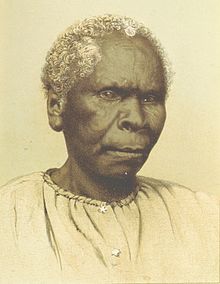Truganini
Truganini (* around 1812 , probably Bruny Island ; † May 8, 1876 in Hobart , Tasmania ), also Lalla Rookh, Tucanini, Trugernanner and Trukanini , was long considered the last " thoroughbred " Tasmanian woman , but was survived by Fanny Cochrane Smith .
Early life
Truganini was a daughter of the Aboriginal Elder Mananga of Bruny Island . Her mother, sister, uncle and the man she was to marry were killed or kidnapped by the British occupiers. She married three times, her last husband was the last "thoroughbred" Tasmanian William Lanne . One of Truganini's husbands was named Woorrady.
Truganini and Robinson
After the Black War and the so-called Black Line, Truganini was brought to Wybalenna on Flinders Island like the other Aborigines , where Chief Protector of Aborigines George Augustus Robinson had her deported. Following his promise to a place protected from attacks by the European invaders, she went with him to Port Phillip in 1838 , where Robinson planned a camp similar to that in Wyballena. Truganini is the Aboriginal people about whom most of the detailed information is known. As Robinson's long-time companion in Tasmania and Australia, Robinson learned a lot about Aboriginal culture through her. Robinson kept numerous records that enabled scientific research into the culture and life of the Tasmanians. Wybalenna was dissolved in 1847, and the 47 survivors of the original 220 Aborigines came to Oyster Cove , a former convict settlement , like them . She was the last Tasmanian survivor on Oyster Cove. She died in Hobart in 1876.
legacy
Two years after her burial, she was exhumed and subjected to scientific research. From 1903 to 1907 her skeleton was exhibited in the Tasmanian Museum . It was not until a hundred years after her death that Truganini's remains were cremated according to her testamentary wishes, after numerous further scientific investigations. Her ashes were scattered in the D'Entrecasteaux Canal near her birthplace .
In 2002, Truganini hair and skin along with other Aboriginal human bones in the Royal College of Surgeon's museum at Oxford were given to Rodney Dillon, the Tasmanian representative of the Aboriginal and Torres Strait Islander Commission in Great Britain. Jeanette James, a member of the Aboriginal delegation, said in Britain that the human remains of Truganini and those of the unidentified Aborigines are buried according to Aboriginal ceremonies.
The Australian rock band Midnight Oil named one of their songs after her. Truganini is also one of the main characters in Mudrooroo's novel Doctor Wooreddy's Prescription for Enduring the Ending of the World , which is about the last survivors of the Tasmanian Aborigines - from the perspective of those affected.
Individual evidence
- ↑ a b c d Information from www.womenaustralia.info , accessed on June 18, 2009
- ↑ guardian.co.uk : Patrick Barkham, Amalie Finlayson: Museum returns sacred samples. Remains of last Tasmanian Aborigine to be put to rest , in The Guardian, May 31, 2002, in English, accessed October 31, 2001
literature
- Antje Kühnast: "In the interest of science and the colony". Truganini and the legend of the extinct races . In: Wulf D. Hund (Ed.): Alienated bodies. Racism as desecration (Postcolonial Studies; 4). Edition Transcript, Bielefeld 2009, ISBN 978-3-8376-1151-9 , pp. 205-250.
- Lyndall Ryan: The Aboriginal Tasmanians . 2nd ed. Allen & Unwin, St. Leonards, NSW 1996, ISBN 1-86373-965-3 .
| personal data | |
|---|---|
| SURNAME | Truganini |
| ALTERNATIVE NAMES | Lalla Rookh; Tucanini; Trugernanner; Trukanini |
| BRIEF DESCRIPTION | last “thoroughbred” Tasmanian woman |
| DATE OF BIRTH | around 1812 |
| PLACE OF BIRTH | unsure: Bruny Island |
| DATE OF DEATH | May 8, 1876 |
| Place of death | Hobart , Tasmania |

